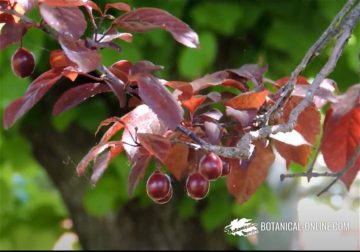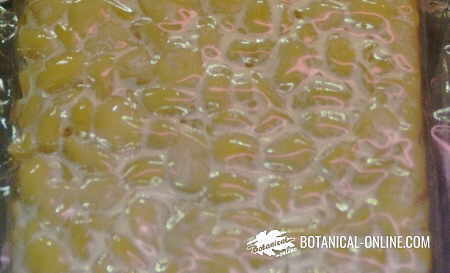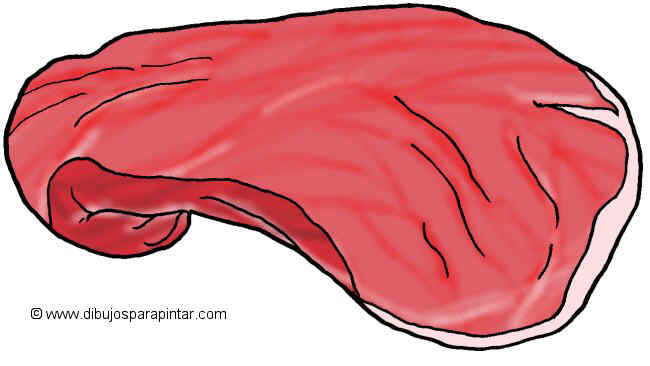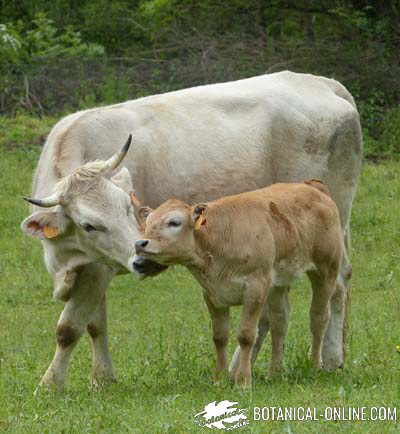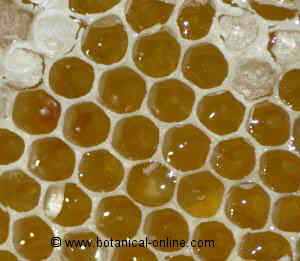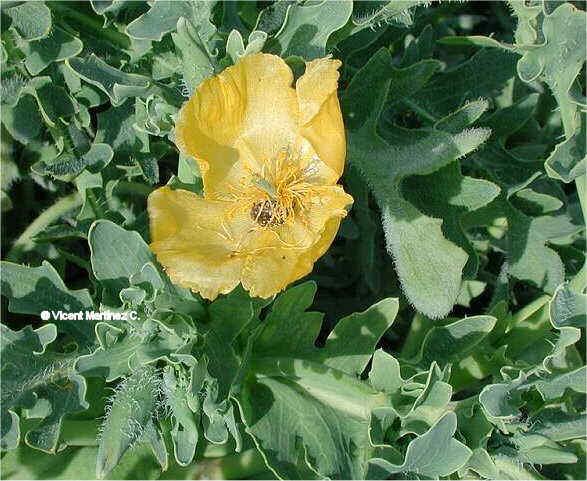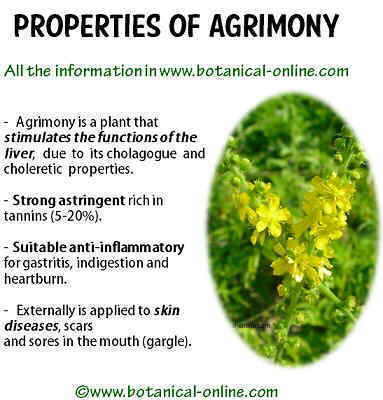Contents
- 1 How to grow cherry plum
- 1.1 Appropriate growing conditions
- 1.2 Soil for cherry plum
- 1.3 Watering cherry plum
- 1.4 Reproduction of cherry plum
- 1.5 Pests and diseases of cherry plum
- 1.6 How is plum powdery mildew treated?
- 1.7 How to treat plum silver leaf?
- 1.8 How to treat plum gummosis?
- 1.9 Cherry plum as a carrier of viral diseases
How to grow cherry plum
 Appropriate growing conditions
Appropriate growing conditions
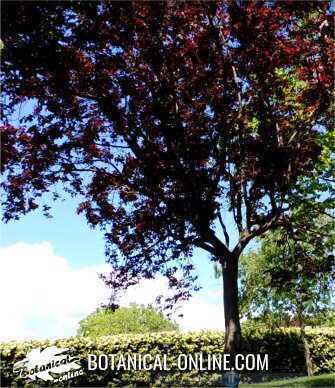
It can be grown in cool or temperate climates although it prefers mild climates. In cool places it is better to plant it in full sun. Even in warm places its foliage improves when it is in full sun. It can be grown in semi-shade.
This tree requires a cold season in winter to produce fruit. It can perfectly withstand frost in winter. Late frosts, when it has already flowered, can spoil the harvest.
Soil for cherry plum
Cherry plum is not too much soil-demanding. It can grow with relatively poor soil although it does not tolerate clay soils. However, a soil that is alkaline in nature (pH between 5.5 and 6.5), well drained and rich is where it achieves growth and greater fruit production.
For the tree to grow properly, it should be fertilized with nitrogen and phosphate.
Watering cherry plum
Cherry plum prefers soils with a certain degree of humidity, although it can withstand not very intense or prolonged droughts. The best thing to do is an abundant irrigation during the fruit-bearing time and a period of little irrigation for maturation and harvesting.
A ground with little drainage that retains water produces numerous fungal diseases.
It is good to cover the soil with organic mulch.
Reproduction of cherry plum

Fruits of Prunus cerasifera Reproduction by seeds in spring:
- Using cold stratified seeds.
- Transplant at 12 months in its definitive place
- 3-5 meter tree spacing
- Reproduction by semi-mature cutting in summer
- Reproduction by graft on stock: This species of plum is commonly used as a graft pattern for other plum trees, including Japanese plum trees, and for other Prunus, such as pear trees, apple trees, etc.
 Pests and diseases of cherry plum
Pests and diseases of cherry plum
The main pests that affect it are:
– Mealybugs
– Aphids
– Rabbits: They gnaw on logs
– Birds: They eat the fruits
Among the main diseases we can mention the followings:
– Rust
– Peach leaf curl: It is a disease produced by the fungus Taphrina deformans that causes the deformation and thickening of the leaves. Later, they turn reddish or yellow and fall off. It also produces yellow or brownish spots on the fruits.
The treatment is based on the preventive application of a copper fungicide and a treatment of infected specimens based on Ferbam diluted in water. Do not apply the latter immediately after applying copper compounds.
– Powdery mildew: It is produced by the fungus Sphaerotheca pannosa. This disease is caused by infection of spores from diseased trees to healthy trees. It manifests itself on the leaves with the appearance of a whitish powder. The leaves curl upward, turn yellow and fall.
A white spot is produced on the fruits that later turns brown and hard. All this makes them useless.
How is plum powdery mildew treated?
Preventive treatment is carried out by applications of liquid sulfur. Should be applied once when the flower petals fall. Again, it should be applied when the fruit is beginning to form and, finally, when the fruit has reached its size before ripening.
The curative treatment is carried out by applying chemical treatments based on Triazole or methyl thiophanate.
– Silver leaf: It is a disease produced by the Chondrostereum purpureum fungus that mainly affects all plums, but it is quite common in other Rosaceae such as apple, pear, cherry, etc.
First of all, the fungus develops as a host on the trunks of other species like willows, oaks, poplars, elms, eucalyptus, etc. As the fungus grows it acquires a multiple outgrowth appearance formed by many superimposed wavy sheets that surround the trunk (It is the basidiocarp or spore-producing body). It has a texture similar to cork with the live parts of violet color while the surface is gray with abundant white hairs.
The spores produced by this fungus are dispersed by the wind. When they fall on a specimen that has an open wound, they infect the sap producing the aforementioned symptoms.
The disease is progressive, causing the death of the branches and the plant if it is not solved.
How to treat plum silver leaf?
The best method is prevention, preventing the tree from becoming infected. To do this, the following tips should be taken into account:
- Avoid injuries as much as possible.
- Avoid pruning in rain or high humidity. Moisture favors infection.
- Prune in summer. The presence of this disease is the reason why plums and cherry trees should be pruned in summer when the climate is drier and there is less presence of spores.
- Cover pruning wounds with fungicidal paint to prevent spores from penetrating. This must be done quickly. It should not be allowed to pass more than 15 minutes from the cut to the application of the paint. A single application is enough.
In case of infection, curative treatment is needed. The only treatment is to cut and burn the affected branches and cover the wounds or cuts with fungicidal paints.
When the disease affects the roots or the interior of the trunk, it no longer has a solution.
– Bacterial gummosis: It’s a disease caused by the bacterium Pseudomonas syringae that produces cankers or fetid and gummy tumor enlargements on the branches and trunks. When it affects the buds of flowers or leaves, it dies. Likewise, the affected branches can rot.
This bacterium penetrates through tree wounds or simply the small penetrations left by the leaves when they fall.
It is favored by the presence of high humidity and heat. Rain and fog are the main factors that favor its dispersion.
The best for its treatment is prevention. An attempt will be made to avoid injuries as much as possible and to prevent water from being trapped in the ground. (It favors in this aspect the cultivation on raised ridge).
How to treat plum gummosis?
Among the most suitable treatments are the following:
- To prune them in summer to eliminate the affected branches and give the specimen more vigor.
- To remove grasses and weeds from under the tree. (The bacteria can remain dormant in them)
- To provide the appropriate fertilizer so that the specimen has more strength to avoid infection.
- To paint the pruning wounds with waterproof paint mixed with 2% copper oxide. To apply an application of this paint to the base of the trunk as protection.
- To apply the appropriate copper-based phytosanitary products (copper sulfate, copper oxychloride, cuprous oxide, or copper hydroxide).
The cherry plum tree is the carrier of some viral diseases that can affect other fruit trees of the genus Prunus like for example apricots, peaches, almonds, cherry trees or other plums.
For this reason the growers of these trees are against the planting of cherry plums in parks, gardens or avenues. This tree can be a living reservoir for these diseases. These include, for example:
- Plum plox virus (PPV): It is the main virus that affects fruit trees.
- Hop aphid (Phorodon humuli): It is an aphid that has this tree and those of the same genus as hosts during the winter. When spring arrives, the insect leaves the tree to attack the hop plantations, being its main pest.
![]() More information on cherry plum tree and plums
More information on cherry plum tree and plums


